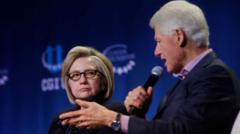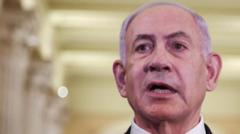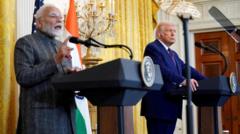Since President Trump's inauguration, missile and drone strikes from Russia have skyrocketed, leading to renewed calls for improved military assistance to Ukraine amid ongoing aggression.**
Surge in Russian Attacks on Ukraine: Analyzing Trump’s Presidency Impact**

Surge in Russian Attacks on Ukraine: Analyzing Trump’s Presidency Impact**
Recent analysis reveals significant rise in Russian offensives against Ukraine following Trump's return to office, raising concerns over US military support and strategy.**
Despite Trump's vows for a ceasefire, Russian aerial assaults have soared dramatically since his inauguration. The BBC Verify analysis highlights a sharp increase in drone and missile attacks, attributing the escalation partly to the pauses in military assistance to Ukraine. During Trump's campaign, he positioned himself as a stabilizing force capable of swiftly resolving the conflict, yet the reality has proven starkly different.
In January, shortly after Trump resumed presidency, incidents of aerial attacks surged to unprecedented levels, exceeding previous heights seen under former President Joe Biden. The data indicates that a staggering 27,158 munitions were launched from Russia between Trump's inauguration and mid-July, dwarfing the 11,614 recorded during the last six months of Biden's term. This serves to underscore a troubling pattern of increased aggression as military intelligence reports a significant rise in Russian missile and drone production capabilities.
In the face of rising hostility, Trump has faced criticism for perceived leniency towards Russia, particularly regarding military aid to Ukraine. His administration temporarily suspended vital military supplies earlier in the year. While these decisions were reversed, they coincided with an uptick in Russian assaults. Reports suggest that Russia’s missile production capacity has accelerated, now producing 85 ballistic missiles monthly and 170 units of 'kamikaze' drones every day.
The heightened attacks have instigated urgent demands for the U.S. to bolster its military support for Ukraine, with analysts pointing out that the current limitations have left Ukraine vulnerable to ongoing Russian hostility. Some U.S. lawmakers argue that Trump's approach could embolden Russia’s aggression if clear and robust support for Ukraine isn’t maintained.
As violence rages on, journalists and civilians in Ukraine convey the harrowing effect of this sustained offensive, with reports of casualties and devastation occurring regularly in urban centers like Kyiv. The conflict's toll on public morale is palpable, with many, like local journalist Dasha Volk, expressing daily anxiety over living under constant threat.
Senator Chris Coons emphasized that the fluctuation in U.S. military support may have inadvertently contributed to Moscow's aggressive posture, insisting Washington must remain committed through substantial military assistance to deter further assaults. The future of this conflict and U.S. involvement remains uncertain, as the dynamics evolve under Trump's administration, leaving many to question what path lies ahead for Ukraine.
In January, shortly after Trump resumed presidency, incidents of aerial attacks surged to unprecedented levels, exceeding previous heights seen under former President Joe Biden. The data indicates that a staggering 27,158 munitions were launched from Russia between Trump's inauguration and mid-July, dwarfing the 11,614 recorded during the last six months of Biden's term. This serves to underscore a troubling pattern of increased aggression as military intelligence reports a significant rise in Russian missile and drone production capabilities.
In the face of rising hostility, Trump has faced criticism for perceived leniency towards Russia, particularly regarding military aid to Ukraine. His administration temporarily suspended vital military supplies earlier in the year. While these decisions were reversed, they coincided with an uptick in Russian assaults. Reports suggest that Russia’s missile production capacity has accelerated, now producing 85 ballistic missiles monthly and 170 units of 'kamikaze' drones every day.
The heightened attacks have instigated urgent demands for the U.S. to bolster its military support for Ukraine, with analysts pointing out that the current limitations have left Ukraine vulnerable to ongoing Russian hostility. Some U.S. lawmakers argue that Trump's approach could embolden Russia’s aggression if clear and robust support for Ukraine isn’t maintained.
As violence rages on, journalists and civilians in Ukraine convey the harrowing effect of this sustained offensive, with reports of casualties and devastation occurring regularly in urban centers like Kyiv. The conflict's toll on public morale is palpable, with many, like local journalist Dasha Volk, expressing daily anxiety over living under constant threat.
Senator Chris Coons emphasized that the fluctuation in U.S. military support may have inadvertently contributed to Moscow's aggressive posture, insisting Washington must remain committed through substantial military assistance to deter further assaults. The future of this conflict and U.S. involvement remains uncertain, as the dynamics evolve under Trump's administration, leaving many to question what path lies ahead for Ukraine.

















